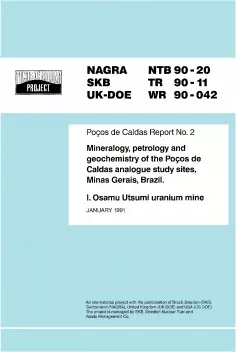
Technical Report NTB 90-20
Poços de Caldas Report No.2Mineralogy, petrology and geochemistry of the Poços de Caldas analogue study sites, Minas Gerais, Brazil. 1: Osamu Utsumi uranium mine
The lithology of the Osamu Utsumi mine is composed mainly of a sequence of volcanic and subvolcanic phonolites and nepheline syenite intrusions similar to those of the Poços de Caldas caldera complex; volcanic breccia pipes about 80 m in diameter also occur, characterised by U-Th-Zr-REE mineralisation concentrated in the matrix. A strong hydrothermal alteration, related to the formation of the breccias, has resulted in the potassic alteration and pyritisation of the phonolites and syenites, with a low-grade mineralisation of disseminated pitchblende. The potassic alteration has transformed all feldspars into pure potash feldspars, nepheline into illite and kaolinite, and clinopyroxenes, which are the primary REE-bearers, into mixtures of TiO2-rich minerals, clay minerals and pyrite. The enrichment of K, S, U, Th, Pb, Rb, Ba and Mo was accompanied by a strong depletion in Ca, Na, Mg and Sr. Fluid inclusion data indicate temperatures around 250°C and a KCI-H2O mixture with approximately 7 wt.% KCI for the hydrothermal fluids. For fluids in the breccia pipes that transported additional Zr, Hf and F, the inclusions indicate boiling and give temperatures of 210°C with 40 – 45 wt.% KCI for a KCI-NaCI-H2O brine containing FeSO4 and KF. Ultramafic dykes (dated to 76 Ma) with carbonatitic affiliation put a younger age limit on the hydrothermal event.
As a result of supergene weathering below a lateritic soil cover 20 to 40 m thick and a saprolite zone 15 to 60 m thick, the pyrites in the rocks have been oxidised to varying depths of 80 to 140 m below surface, resulting in a redox front marked by a contrasting colour change in the rock from oxidised (yellow/buff) to reduced (grey/green) rock. In the vicinity of water-bearing fissures these redox fronts have penetrated to greater depths. Due to mobilisation in the oxidised zone and precipitation immediately below the redox front, a secondary pitchblende mineralisation, partly occurring as nodules associated with secondary pyrite, has been developed. This secondary pyrite is sometimes related with CdS and has a δS of -13 ‰ compared to δS values of -3.63 to +1.24 ‰ for hydrothermal pyrites; the low δS values of the former are attributed to bacterial action. In the immediate vicinity of the redox front, dissolution of the potash feldspar becomes apparent and the kaolinite content begins to increase. The marked colour change at the redox front is caused by the presence of hydrous ferric oxides that, with time, evolve from amorphous Fe-hydroxides to goethite and hematite. On the oxidised side alunite-jarosite minerals are frequent. The porosity increases by 5 to 8 % (almost doubled) at the redox front.
Gibbsite is present when potash feldspar has been removed at the saprolite-laterite contact. Many of the REEs are associated with phosphate-rich clays (including the crandallite group minerals) and seem to be hardly mobilised by the oxidising weathering fluids. Only a slight general loss of REEs was observed between oxidised and reduced rock, with the degree of loss being greater for the light REEs. Certain indications of a fractionation of Ce and Eu from the other REEs are present.
